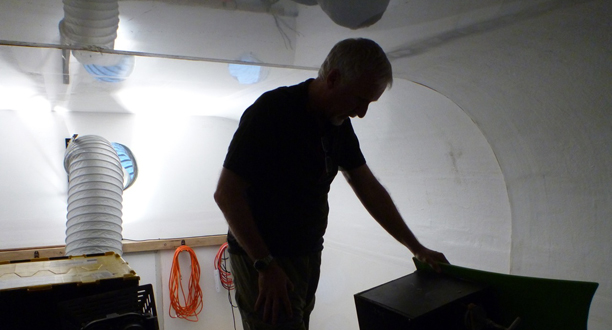Keep on Truckin’

Jacquinot Bay, New Britain Island, Papua New Guinea
Another test dive was to begin after sunset. When Jim walked into the sub hanger at 2 p.m. to start the predive checklist, the Academy Awards were underway in Los Angeles. Jules O’ Loughlin, the expedition’s director of photography, saw Jim and said, “Congratulations on the Cameron-Pace contribution to the cinematography Oscar for Hugo.” Jim grinned. “Thanks for telling me and reminding me I have another life,” he said. “Now, let’s get going on the checklist.”
An hour after the blood-orange sun slipped into the ocean, the predive checklist was complete, and Jim asked John Garvin and Ben Orchard to lower the steel hatch and secure its bolts. A few minutes later, the sub was eased up from its cradle so Ty Boyce and Bruce Sutphen could secure the two stabilizer fins to her aft end. Dave Wotherspoon, who coordinates the launch and recovery, was about to signal the crane operator to lift the sub and ease it across the deck when someone noticed silicone oil dripping out of the starboard side of the lower pod. Ty had the cover off in less than a minute. When the lower pod science door was shut for the last time, it pinched an oil-filled electrical hose leading to the steel shot dumper. Twenty minutes later, Ty and Ron Allum had decreased the pressure in the hose and replaced it. The sub was ready for launch.
Then, five minutes later, Dave saw drops of oil coming out of a battery-switching box on the upper end of the sub. This time the problem was more serious. The polycarbonate box—used to switch power from one set of batteries to another—is filled with oil to keep seawater out of its critical parts, and there was a leak in its oil compensation bladder that would take a significant period of time to fix. Jim decided to scrub the dive. At 9:15, he climbed out of the sphere. Later, he walked around the sub and into the mess hall and told the team how much he appreciated the work they had done since the last dive. “We can take one hit,” he said. “We can take two. We can take five. And we’ll keep on truckin’.”
Every day, towering thunderhead clouds boil up into the blue sky around the ship. Created by humid equatorial air they soar over the island and the ocean, growing bigger and whiter as the day wears on. Last night, one of them unleashed a torrent of rain on the ship and then drifted north over the island, firing jagged lightning bolts into the 5,000-foot (1,524-meter) mountains.
The thunderheads are especially striking at sunrise. Each morning I get up before six and go on deck hoping to see a high blaze of pink in the east. This morning I was on the upper forecastle deck, heading toward the bow in the dark, when I heard a soft rustling in the water in the lee of the ship. I looked down into the golden glow of the ship’s floodlights and saw a dense swarm of small fish. There were thousands of them pressed together in a writhing, spinning mass the size of a small truck. They were moving as one, feeding on tiny organisms drawn to the ship’s illumination. When the mass caught the light at a certain angle, the water filled with mirrored flashes. Without warning, the mass shivered, parted, and an enormous slash of silver appeared near its center and vanished. Ten seconds later, it happened again. Some twilight carnivore was devouring the energy needed to feed its solid, muscular frame. It was confirmation that within the great salt womb of the sea, the line between life and death is invisible.
Photograph by Joe MacInnis



